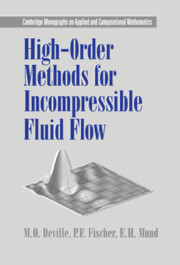Book contents
- Frontmatter
- Contents
- List of Figures
- Preface
- 1 Fluid Mechanics and Computation: An Introduction
- 2 Approximation Methods for Elliptic Problems
- 3 Parabolic and Hyperbolic Problems
- 4 Multidimensional Problems
- 5 Steady Stokes and Navier–Stokes Equations
- 6 Unsteady Stokes and Navier–Stokes Equations
- 7 Domain Decomposition
- 8 Vector and Parallel Implementations
- A Preliminary Mathematical Concepts
- B Orthogonal Polynomials and Discrete Transforms
- Bibliography
- Index
1 - Fluid Mechanics and Computation: An Introduction
Published online by Cambridge University Press: 24 August 2009
- Frontmatter
- Contents
- List of Figures
- Preface
- 1 Fluid Mechanics and Computation: An Introduction
- 2 Approximation Methods for Elliptic Problems
- 3 Parabolic and Hyperbolic Problems
- 4 Multidimensional Problems
- 5 Steady Stokes and Navier–Stokes Equations
- 6 Unsteady Stokes and Navier–Stokes Equations
- 7 Domain Decomposition
- 8 Vector and Parallel Implementations
- A Preliminary Mathematical Concepts
- B Orthogonal Polynomials and Discrete Transforms
- Bibliography
- Index
Summary
According to the Greek philosopher Heraclitus, who used to say “πανταρ∈ι …,” daily life is concerned with the flow of ordinary fluids: water, air, blood, and so forth, in very common situations like breathing, coffee drinking, and hand washing.
Most flows are generated by nature (e.g., oceans, winds, rivers) and by human industrial activity (e.g., planes, cars, materials processing, biomedical engineering). There is a need to model fluid flow problems in order to improve the basic understanding of these complex phenomena and to increase the design quality of technological applications. With the advent of large and powerful computational tools, modeling has become more and more a substitute for direct experimentation. In some circumstances, experimentation may be too expensive – particularly if it leads to the destruction of the facility – or even impossible to perform, so that modeling is the only reasonable way to get answers and to study a range of parameters for optimal design.
Viscous Fluid Flows
We know from experience that many flows are set into motion by shear forces, and hence viscous effects play a vital role in fluids. In general, the viscosity depends on the shear rate (roughly speaking, the velocity gradient), as is explained by non-Newtonian theory. In this book, however, we will restrict ourselves mainly to the case of viscous Newtonian incompressible fluids in isothermal situations or under the influence of thermal convection as described by the Boussinesq approximation.
- Type
- Chapter
- Information
- High-Order Methods for Incompressible Fluid Flow , pp. 1 - 32Publisher: Cambridge University PressPrint publication year: 2002

